This is a problem where the biggest step towards a solution is not police, but signage and paint…
7 minute read
March 12, 2013, 10:16 PM
According to an article on Patch.com, since January 22, four pedestrians and one cyclist have died in collisions with cars in the eastern part of Montgomery County. The cyclist was struck in downtown Silver Spring. The pedestrian fatalities all occurred outside the Beltway. One involved a woman’s being struck while on the sidewalk, and the other three were struck and killed while attempting to cross major arterial roads in the county – specifically, Columbia Pike (US 29), Connecticut Avenue (MD 185), and Georgia Avenue (MD 97). Ken Silverman, an analyst for county councilwoman Nancy Navarro, created a map showing the location of the accidents.
Now in looking at all of this, I latched onto the fatalities related to crossing the arterials. I am on each side of the pedestrian-driver coin in Montgomery County at various times, and so I am familiar with both driving around pedestrians, and walking around cars. I have also crossed Georgia Avenue on foot many times. In these instances, the Columbia Pike incident happened in the southbound lanes at the intersection with Oak Leaf Drive in White Oak. The Connecticut Avenue incident happened at the intersection with Everton Street, in the Wheaton area. The Georgia Avenue incident occurred at the intersection with Heathfield Road in Aspen Hill. I looked at these areas, and there are some common factors in all of them:
- All three incidents occurred after dark
- All three incidents occurred at unmarked crosswalks (any intersection is considered a legal crosswalk in Maryland whether it’s marked or not)
- The main roadway in all three locations is a six-lane divided highway with three lanes on each side
- There are bus stops on both sides of the road at all three locations
- There is street lighting on the side of the road where the incidents occurred (Columbia Pike and Georgia Avenue have lighting on only one side in these areas, and Connecticut Avenue has lighting on both sides)
I hope you see the pattern here: these people were most likely struck while crossing these major roadways to reach a bus stop. This is a major problem, and I sense that there is plenty of room for improvements that will make the roads safer for both drivers and pedestrians.
The incident on Georgia Avenue occurred about a mile away from where I live. The intersection with Heathfield Road is just north of Home Depot. So I visited the location this evening to take some photos of the area at night (wearing my Metro safety vest so that I was visible), using 15-second exposures (thus these photos make the area appear brighter than it really is). Here’s what I found…
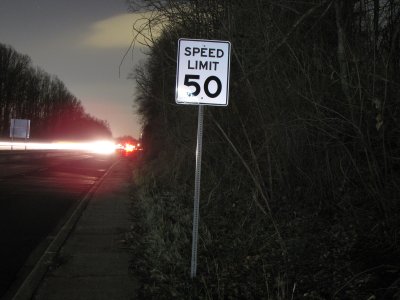
The speed limit through this area is 50 mph. Generally, the speed limit on Georgia Avenue gets progressively slower as one travels south between the Intercounty Connector and the Beltway. The speed limit is 50 from the Intercounty Connector to just north of Connecticut Avenue. There, it drops to 45, and stays at 45 until just south of Glenmont station. There, the speed limit drops to 35 for the remainder of the distance to the Beltway.
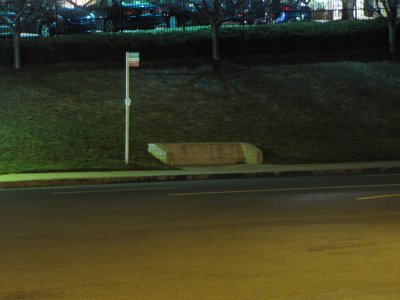
The bus stop on the east side of Georgia Avenue at Heathfield Road, served by the Y5/Y7/Y8/Y9 bus routes. There are no streetlights on that side of Georgia Avenue. The orange light in the foreground is coming from streetlights on the opposite side of Georgia Avenue. The greenish light to the left of the bus stop comes from an apartment complex’s security lighting.
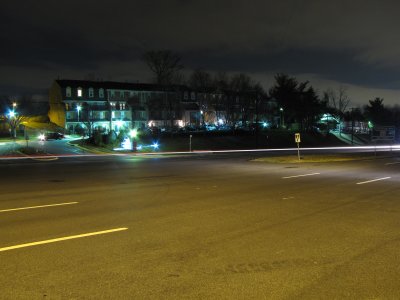
Wider view of the same area, facing approximately southeast. The southbound lanes of Georgia Avenue are closest to the camera. Note lack of pavement markings for a pedestrian crossing, and also note how the security lighting, even with the help of my long exposure photography, does not reach the other side of the roadway.

Same location, facing approximately northeast. Again note lack of a marked crosswalk, and the dark areas on the road.
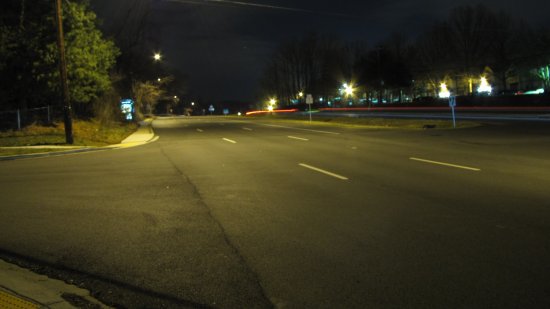
View up Georgia Avenue from Heathfield Road. Southbound traffic is coming off of a slight curve in the road and continues down a small slope towards Connecticut Avenue from this location. Due to the hill, pedestrians are lower than the driver’s horizon until fairly close. See for yourself on Street View. A pedestrian crossing sign exists before the curve.
And then for those wondering, this is what Georgia Avenue looks like at night in real life, taken without the aid of long exposure times, about a mile north of this location at Leisure World Plaza:
Councilwoman Navarro’s analyst, Ken Silverman, mentioned in a blog post on this matter about making various physical improvements to the area and also aggressive enforcement of the area. Silverman also, however, said, “It may not be feasible for everyone to dress head to toe in reflective orange[…],” which to me sends the wrong message. It seems to suggest that one is invincible when wearing high-visibility clothing. You’re not invincible just because you’re wearing bright yellow or orange, plus reflectors. I wore a safety vest to take these photos, but I behaved like I wasn’t wearing it. These folks who think they’re invincible when they’re wearing high-visibility clothing can still get hit just as easily as someone who isn’t wearing any. So shame on him for that.
I also don’t know if aggressive policing is necessary just yet. That seems to be something that you do after you make improvements to the roadway. In fact, the thing that seems quickest and easiest to me would be to mark those crosswalks adjacent to bus stops. This is helpful for both pedestrians and drivers. For pedestrians, it says, “Cross here.” While I was taking these photos, I observed several people crossing the road in any number of different ways. Not all of them took a straight path across Georgia Avenue, with some crossing diagonally from the bus stop to Heathfield Road. Some guidance seems in order here. For drivers, a marked crosswalk serves as a reminder that pedestrians will be crossing the road at this location. I’ve been driving that stretch of road for years, and it never really occurred to me before that this is an area with high foot traffic. I always think of Georgia Avenue as a place where angels fear to tread. I try to avoid crossing Georgia Avenue on foot whenever possible. But as I observed tonight, lots of people cross to use that bus stop. A marked crossing is a constant reminder that people cross the street here.
Another solution along with explicitly marking the crosswalks is more/better signage. I don’t think it’s necessary to install overhead flashers for these sorts of crossings. However, it might be a wise idea to install flashers on the pedestrian crossing signs that already exist. I again use my own experience here, and didn’t realize that this was a high cross-the-street area. Draw attention to it. And yes, flashing lights are noticeable.
Additionally, as far as physical improvements go, the lighting needs to be improved dramatically along much of Georgia Avenue. Currently, the streetlights on this section of Georgia Avenue are a bit far apart, with large dark patches on the sidewalks and the roadway. The fixtures themselves also appear to be quite old. I have no doubt that the fixtures are at least 30 years old, and probably even older than that. This seems to be something that could save the county money in the long run through reduced energy usage by replacing the older streetlights with newer and more energy-efficient models (think LEDs). And in addition to energy efficiency, newer fixtures use the light more effectively as well, pointing it down at the street where it belongs, vs. the older fixtures, which don’t do as well in this regard. This also would be the opportunity to reimagine placement of light fixtures. Why only light one side of the street? That is also the perfect time to remedy truly dark stretches of road where pedestrians go. Take Georgia Avenue between Bel Pre Road and Leisure World:
No, you are not imagining things. There are no streetlights in that area, which leaves Georgia Avenue very dark. And due to the speed limit, plus the way people tend to speed, people drive through that area at freeway speeds, and there are four bus stops along that stretch (two on each side). Lighting would make this a far safer stretch of roadway for drivers and pedestrians alike.
And as with marked crosswalks, lighting is a situation where everyone benefits. The drivers can see better, pedestrians can see better, and each has a far better chance of seeing the other.
Then lastly, I kind of alluded to it earlier, but a lowered speed limit would increase pedestrian safety as well in these areas with higher foot traffic. It might be worth evaluating whether the Georgia Avenue corridor has grown to the point where it is a good idea to extend the 35 mph speed limit north of where it currently ends. It could also be an option to eliminate the speed increase to 50 mph at Connecticut Avenue and leave it at 45 all the way to Olney. Or step it down to 40 from Glenmont Metro to Bel Pre Road.
And then once you make all of the physical improvements, then you can pay for it all by putting the cops out on fundraising detail in the area. But you have to agree – the status quo is no longer acceptable, because one life lost, let alone three lives lost for the same reason, is too many.
Categories: DC area local news, Silver Spring
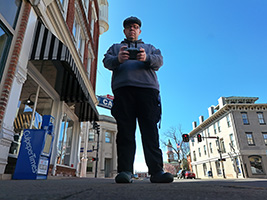









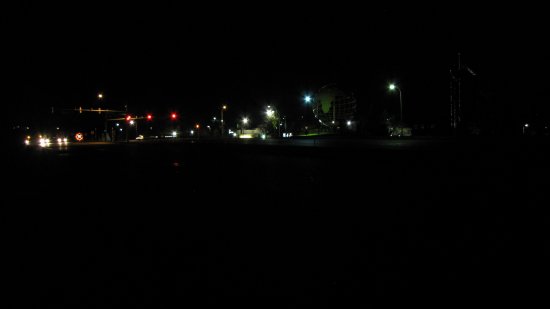
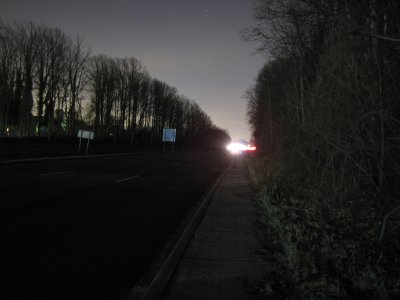
I tihnk on the avenue the side walks are much narrower and smaller. I doubt if that has anything to do with it though.
On that part of Georgia Avenue, the sidewalks don’t seem to be any narrower than other sections of the same road. The section near Leisure World is similar width, as is the part that I use on days that I walk home from the Metro. However, there is one difference between Georgia Avenue and every street that intersects with it between Hewitt Avenue and Bel Pre Road: Georgia Avenue’s sidewalks are directly against the curb, and are not set back by a few feet like on all of these cross streets, including six-lane Connecticut Avenue. This is the typical sidewalk setback on the side streets:
http://files.schuminweb.com/life-and-times/2010/year-2010/full-size/52.jpg
Would a sidewalk setback make Georgia Avenue’s sidewalks safer? Yes. Will it happen? Highly unlikely, unless it’s being done with other major road reconstruction, since many of the sidewalks have been redone within the last two years. There are also right-of-way issues with setbacks in some places, such as between Hathaway Drive and Rippling Brook Drive, where the properties along Georgia Avenue (which front Foxhall Drive) are at a higher grade, and there’s a steep slope between the end of the properties and the sidewalk. But having walked them many times, they are a bit too close to the curb for a 45 mph speed limit, especially when people routinely drive 60 mph down it.
The sidewalks on Georgia Avenue weren’t a contributing factor to the accident, nor in the other two accidents on their respective roads, to my knowledge. It is worth noting, however, that Connecticut Avenue has service roads in the area of the accident, and Columbia Pike changes from an arterial to a limited-access road at Oak Leaf Drive, i.e. sidewalks end there, and there is a cloverleaf interchange with New Hampshire Avenue very close by. The Columbia Pike accident location probably deserves its own study, since going southbound on Columbia Pike, there are no pedestrian crossing warning signs between the last ramp of the cloverleaf interchange and Oak Leaf Drive to tip drivers off to the fact that the road is changing to an arterial from limited-access, and taking on more characteristics of a surface street, such as having pedestrians.